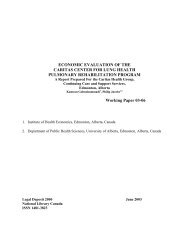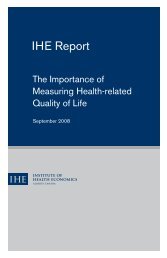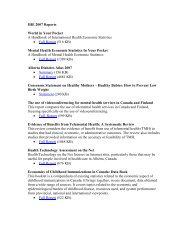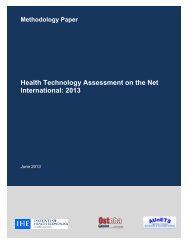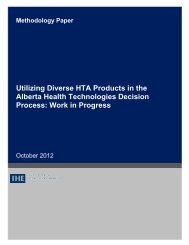Bariatric treatments for adult obesity - Institute of Health Economics
Bariatric treatments for adult obesity - Institute of Health Economics
Bariatric treatments for adult obesity - Institute of Health Economics
- No tags were found...
You also want an ePaper? Increase the reach of your titles
YUMPU automatically turns print PDFs into web optimized ePapers that Google loves.
approximately 3 to 5 kilograms. For people with a BMI <strong>of</strong> 35 kg/m 2 or greater, surgical therapyleads to substantial reductions in weight <strong>of</strong> 20 kilograms or more.Both counseling-based and drug-based maintenance interventions were helpful in retaining weightloss. Reduction <strong>of</strong> 5% to 7% <strong>of</strong> body weight is associated with lower incidences <strong>of</strong> diabetes, reducedblood pressure, and improved dyslipidemia. Greater weight loss has been linked with greaterimprovements in glycemic control and lipids in limited surgical outcomes data.In terms <strong>of</strong> adverse events, potential harms <strong>of</strong> counseling-based interventions were not reported.Sibutramine is sometimes associated with increased blood pressure (mean increase <strong>of</strong> 0 to 3.5mmHg) and orlistat causes gastrointestinal distress in 15% to 37% <strong>of</strong> patients taking the drug.Surgical procedures lead to peri-operative mortality in less than 1% <strong>of</strong> patients, and over a 5-yearperiod up to 25% <strong>of</strong> patients require a reoperation.Clinical Practice Guidelines/Position StatementsSeveral clinical practice guidelines addressed the potential role <strong>of</strong> various bariatric <strong>treatments</strong>trategies <strong>for</strong> patients with <strong>obesity</strong>. Clinical decision on selecting appropriate treatment strategies isbased on BMI and/or waist circumference, risk factors and comorbidities (see Table S.4 in S-section). The majority <strong>of</strong> the documents used the WHO BMI <strong>obesity</strong> classification. No documentwas found that used the Edmonton Obesity Staging System. 55Table T.9 presents an algorithm <strong>of</strong> treatment interventions based on patients’ gender, BMI, waistcircumference, and comorbidities.Table T.9: European clinical practice guidelines, 2008 4BMI (kg/m 2 )Men < 94Women < 80Waist circumference (cm)Men ≥ 94Women ≥ 80Comorbidities25 to 29.9 L L L D30.0 to 34.9 L L D L D35 to 39.9 L D L D L D S≥ 40 L D S L D S L D SAbbreviations: L = life style interventions (dietary therapy and physical exercise); D = drugs; S = surgeryDiscussionAssessment limitationsThe T-section <strong>of</strong> this report suffers from several methodological limitations.First, this report only included systematic reviews/HTAs <strong>of</strong> RCTs as the primary source <strong>of</strong> evidence<strong>for</strong> the safety and efficacy <strong>of</strong> bariatric treatment strategies. RCTs published after the search dates(2005 <strong>for</strong> dietary therapy/exercise, 2003 <strong>for</strong> behavioural therapy, 2008 <strong>for</strong> pharmacotherapy, and2009 <strong>for</strong> surgery) <strong>of</strong> the most recent reviews were not searched due to time constraints. However,most <strong>of</strong> the included systematic reviews/HTAs were published within the last 5 years. For example,the CADTH review on bariatric surgeries was conducted in 2010, which limited the possibility thatmore recent studies on newer surgical procedures (<strong>for</strong> example, sleeve gastrectomy) were missed.<strong>Bariatric</strong> <strong>treatments</strong> <strong>for</strong> <strong>adult</strong> <strong>obesity</strong> 94



